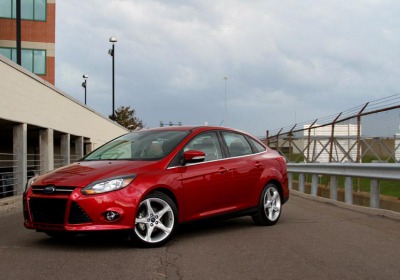GM, Ford, Chrysler advance as market recovers from May dip
Fri, 01 Jul 2011
Automakers, aided by a rise in pickup demand and new models such as the Chevrolet Cruze, Fiat 500 and Ford Focus small cars, posted higher U.S. sales in June.
Sales rose 11 percent at GM, with car demand climbing 28 percent and pickup truck volume up 15 percent. Ford said sales increased 10 percent from a year earlier, when Volvo and Mercury were included in the automaker's results.
Robust demand for Jeeps and a 35 percent jump in Ram truck sales helped the Chrysler Group's June volume advance 30 percent.
Hyundai, Kia and Nissan also advanced.
But sales dropped at Toyota and Honda as the two automotive giants continued to struggle with inventory shortages three months after an earthquake in Japan disrupted output.
Toyota Motor Corp. said demand dropped 21 percent, with Lexus off 38 percent and the Toyota division down 19 percent.
Sales of Volkswagen brand models jumped 35 percent, while Subaru fell for a second-straight month.
Results from the first major automakers to report Friday support forecasts that sales would rebound after falling for the first time in nine months in May. June's seasonally adjusted annual sales rate is projected to come in at about 12 million units.
The SAAR had topped that level for seven straight months--the last three of those above 13 million--before shoppers scaled back in May. Rising gasoline prices, reduced incentives, and vehicle shortages caused by the March earthquake in Japan prompted May's decline.
GM's retail sales rose 16 percent, offsetting a 1 percent decline in fleet shipments. But crossover demand – a bright spot for GM in recent months – fell 2 percent as the automaker dialed back on rental deliveries.
Cadillac was the only GM brand to post a sales decline last month.
Without Volvo, Ford's June sales climbed 13 percent.
Lincoln rebounds
Sales of the new Ford Focus jumped 41 percent, and the Fiesta subcompact posted 5,535 sales, Ford said. Sales of the F-Series pickup rose 7 percent, helped by demand for models equipped with V6 engines.
At Lincoln, which had suffered six straight monthly declines, sales rose 17 percent to 7,361.
U.S. light vehicle sales are up 14 percent through the first five months of the year as the industry continues to climb back from the collapse of 2008-2009.
But consumers remain in a cautious mood because of weak income and job growth, as well as the housing slump.
"Even though the economic news remains pretty mixed, [and] even though the Japanese competitors have lower-than-normal levels of inventory, there's still this high pent-up demand that's backstopping the industry," said Don Johnson, head of GM's U.S. sales operations.
The drop in gasoline prices last month helped lift pickup sales, GM said.
Pump prices drive shift
As long as gas prices don't jump "dramatically," Johnson expects pickup sales to strengthen in the second half of the year.
"As people got over the fear of fuel-price spike, those who actually need a pickup have come back into the market," Johnson said. "We think it's reasonable to assume that will play out for the rest of the year."
Consumers continue to shift to smaller, fuel-efficient models.
Volkswagen said June sales of the Jetta compact surged 88 percent, and diesel-equipped models accounted for 21.3 percent of the VW brand's volume. Chevrolet sold 24,896 Cruze compacts last month, with sales of the more fuel-efficient Eco model representing 17 percent of Cruze volume. Demand for the new Fiat 500 rose 3 percent from May, Chrysler reported.
And Honda said sales of the subcompact Fit increased 20 percent to 4,912 units.
Tight supplies resulting from a March earthquake hurt some Japanese automakers again in June.
American Honda said sales dropped 21 percent, with volume at the Honda brand off 22 percent and Acura down 20 percent.
The Honda brand was also hurt by a 36 percent drop in Civic sales. While both models are assembled in North America, demand for the Accord plunged 38.6 percent and Odyssey minivan sales dropped 25 percent.
At Nissan's Infiniti division, which relies on Japanese plants for the bulk of its U.S. lineup, June sales dropped 24 percent.
"We hit our lowest inventory level at our retailers during the month of June, but our factories are now at full production and thousands of new Infiniti models are on their way to our retailers," Ben Poore, head of Infiniti Americas, said in a statement.
Depleted stockpiles
Automakers began June with 2.18 million vehicles in stock, down from 2.3 million at the start of May. Japanese automakers, hardest hit by the earthquake, had 598,400 units in inventory at the beginning of June, down 18 percent from 730,300 cars and light trucks at the start of May.
Automakers have dialed back on incentives because of depleted inventory levels. The shift has resulted in higher new vehicle transaction prices, hitting an average of $30,009 last month, according to TrueCar.com, an online shopping site.
TrueCar estimates June incentives averaged $2,300 across the industry, down 0.2 percent from May and down 19.8 percent from June 2010.
Detroit automakers have dramatically scaled back on deals, TrueCar says, with the average Ford discount - $2,373 – at its lowest level since September 2002, and Chrysler discounts at their lowest level since February 2003.
"The upside to a lack of inventory on some vehicles is that incentives decreased and transaction prices soared to the highest levels ever recorded – meaning stronger profits for automakers," TrueCar analyst Jesse Toprak said in a statement. "The good news for consumers is as dealer inventory levels are replenished and supply levels return to normal, incentives will begin to increase, lowering transaction prices."
Mike Colias contributed to this report
By David Phillips- Automotive News

